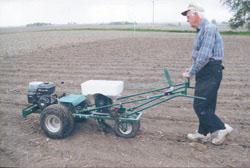 John Beran, Lenox, Iowa, recently sent photos of two home-built, one-row planters he made to use in his big garden.
John Beran, Lenox, Iowa, recently sent photos of two home-built, one-row planters he made to use in his big garden.
One planter is sleeve hitch-mounted on a Deere 212 garden tractor. The other is a self-propelled, walk-behind unit.
“We use a Precision Planting finger pickup seed metering unit on both planters for field corn, sweet corn and popcorn and a Kinze brush-type metering unit for milo/grain sorghum and soybeans,” says Beran.
“We developed these planters in 2001 and have used one or both every year since then. We’ve also used them to do some custom planting. Both are easy and fun to use,” says Beran.
Tractor-Mounted Planter
The tractor-mounted planter has a fertilizer unit as well as a seed metering unit that lets Beran spread fertilizer and plant at the same time. A pair of ground-driven rubber wheels are used to chain-drive both units. “The chain goes first to the fertilizer unit and then to the seed unit,” says Beran.
The drive wheels are followed by a closing wheel off a White planter. A small spring-loaded closing unit off a Deere planter is located just behind the openers and used to bring soil in over the furrow.
Different size sprockets are used to change seed rates, which determines the seed spacing. The fertilizer unit uses small plates that slip under an agitator wheel, and the size of the holes in those plates determines how much fertilizer drops down.
“When I come to the end of the row I pull a lever on the tractor to raise the planter. A spring assist system installed under the tractor helps lift the load,” says Beran. “A hydraulic lift and 3-pt. hitch would make the planter even easier to use.
He used sheet metal to build both the seed and fertilizer hoppers. The fertilizer box holds about 10 lbs. “The boxes aren’t very big because with the manual lift system we need to keep the weight down,” he says.
Self-Propelled Planter
Beran used the transaxle and rear wheels from a Massey-Ferguson Model 8 garden tractor and a 6 1/2 hp Briggs & Stratton engine to build the self-propelled planter. The seed hopper is off a Deere planter and was cut down to half size. A belt runs from the engine back to the transaxle and is controlled by a slip clutch.
The operator holds onto a handlebar to guide the planter. At the end of the row he grabs a pair of rubber-covered grip handles to lift the back end of the planter, which lifts two drive wheels and disengages the seed metering unit.
“On this planter we use a fertilizer unit that’s interchangeable with the seed metering unit,” says Beran. “We apply fertilizer prior to planting or to side dress small growing plants.”
He built a frame that rests on the transaxle to support the engine. “I put the engine in front because it helps balance the weight which makes the planter easier to turn at the end of the row,” says Beran. “A pair of heavy irons run across inside the unit’s front bumper to provide added weight.”
The planter is equipped with a chisel-type opener, which can be moved up or down by changing the position of 2 bolts. A pair of small rubber wheels on back are used to chain-drive the seed metering unit. The wheels are locked together so there’s only one chain driving the seed metering unit. A handlebar-mounted throttle is used to control engine speed.
“The transaxle has three forward speeds. I generally go in second gear, which is a nice speed for walking with the engine at not more than half throttle,” says Beran.
“The tractor-mounted planter can plant about two acres per day and the self-propelled unit one to two acres, depending on the operator. Most of the time I use the self-propelled planter because it’s so handy. I don’t have to hook up anything to a tractor, and it’s small enough that I can work in small areas. And, it gives me plenty of exercise. I just enjoy using it.”
1-800-834-9665
Home-Built Planters For Small Fields, Large Gardens
FARM SHOW Magazine » Home-Built Planters For Small Fields, Large Gardens
Home-Built Planters For Small Fields, Large Gardens
